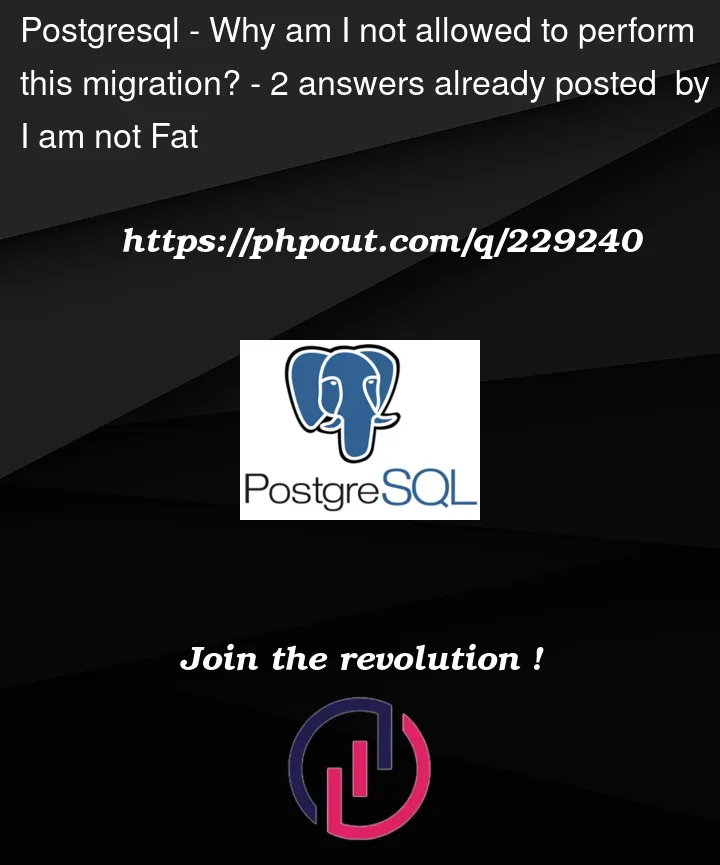I have a postgres database where I use ef to control my migrations code first.
I currently have this table/class.
public class Notification
{
[Key]
public Guid Id { get; set; } = Guid.NewGuid();
public string ActionType { get; set; } = string.Empty;
public string ActionElement { get; set; } = string.Empty;
public string ActionElementType { get; set; } = string.Empty;
public string Message { get; set; } = string.Empty;
public User ForUser { get; set; } = new User();
public User ByUser { get; set; } = new User();
public DateTime CreatedAt { get; set; } = DateTime.UtcNow;
public bool Seen { get; set; } = false;
public bool Clicked { get; set; } = false;
}
to this
public class Notification
{
[Key]
public Guid Id { get; set; } = Guid.NewGuid();
public string ActionType { get; set; } = string.Empty;
public string ActionElement { get; set; } = string.Empty;
public string ActionElementType { get; set; } = string.Empty;
//public string Message { get; set; } = string.Empty;
public Message MessageContent { get; set; };
public User ForUser { get; set; } = new User();
public User ByUser { get; set; } = new User();
public DateTime CreatedAt { get; set; } = DateTime.UtcNow;
public bool Seen { get; set; } = false;
public bool Clicked { get; set; } = false;
}
public record Message
{
[Key]
public Guid MessageId { get; set; } = Guid.NewGuid();
public string MessageContent { get; init; }
public ImmutableDictionary<string, string> MessageContentProperties { get; init; }
}
which have created this migration file:
///
public partial class changeMessageStringToMessageRecord : Migration
{
///
protected override void Up(MigrationBuilder migrationBuilder)
{
migrationBuilder.DropColumn(
name: "Message",
table: "Notifications");
migrationBuilder.AlterDatabase()
.Annotation("Npgsql:PostgresExtension:hstore", ",,")
.Annotation("Npgsql:PostgresExtension:uuid-ossp", ",,")
.OldAnnotation("Npgsql:PostgresExtension:uuid-ossp", ",,");
migrationBuilder.AddColumn<Guid>(
name: "MessageContentMessageId",
table: "Notifications",
type: "uuid",
nullable: false,
defaultValue: new Guid("00000000-0000-0000-0000-000000000000"));
migrationBuilder.CreateTable(
name: "Message",
columns: table => new
{
MessageId = table.Column<Guid>(type: "uuid", nullable: false, defaultValueSql: "uuid_generate_v4()"),
MessageContent = table.Column<string>(type: "text", nullable: false),
MessageContentProperties = table.Column<ImmutableDictionary<string, string>>(type: "hstore", nullable: false)
},
constraints: table =>
{
table.PrimaryKey("PK_Message", x => x.MessageId);
});
migrationBuilder.CreateIndex(
name: "IX_Notifications_MessageContentMessageId",
table: "Notifications",
column: "MessageContentMessageId");
migrationBuilder.AddForeignKey(
name: "FK_Notifications_Message_MessageContentMessageId",
table: "Notifications",
column: "MessageContentMessageId",
principalTable: "Message",
principalColumn: "MessageId",
onDelete: ReferentialAction.Cascade);
}
/// <inheritdoc />
protected override void Down(MigrationBuilder migrationBuilder)
{
migrationBuilder.DropForeignKey(
name: "FK_Notifications_Message_MessageContentMessageId",
table: "Notifications");
migrationBuilder.DropTable(
name: "Message");
migrationBuilder.DropIndex(
name: "IX_Notifications_MessageContentMessageId",
table: "Notifications");
migrationBuilder.DropColumn(
name: "MessageContentMessageId",
table: "Notifications");
migrationBuilder.AlterDatabase()
.Annotation("Npgsql:PostgresExtension:uuid-ossp", ",,")
.OldAnnotation("Npgsql:PostgresExtension:hstore", ",,")
.OldAnnotation("Npgsql:PostgresExtension:uuid-ossp", ",,");
migrationBuilder.AddColumn<string>(
name: "Message",
table: "Notifications",
type: "text",
nullable: false,
defaultValue: "");
}
}
When I apply the migration I get the error message
ALTER TABLE "Notifications" ADD CONSTRAINT "FK_Notifications_Message_MessageContentMessageId" FOREIGN KEY ("MessageContentMessageId") REFERENCES "Message" ("MessageId") ON DELETE CASCADE;
Npgsql.PostgresException (0x80004005): 23503: insert or update on table "Notifications" violates foreign key constraint "FK_Notifications_Message_MessageContentMessageId"
I am not sure I understand the issue here? why is there an foreign key issue here?




2
Answers
Your Notification table likely has a
MessageContentMessageIdthat doesn’t map to a a row with the sameMessageIdin theMessagecolumn.If you want a foreign key there, you’ll need to clean up your data.
For example, in your migration, you can include an update statement to remove everything that can’t be found, by adding a SQL statement to set
MessageContentMessageIdtoNULLfor messsages that can’t be foundYou can wrap it in a
migrationBuilder.SqlfunctionThe error message you’re getting
23503: insert or update on table "Notifications" violates foreign key constraint "FK_Notifications_Message_MessageContentMessageId"typically indicates that there are rows in the "Notifications" table which do not have corresponding entries in the "Message" table.Here’s what’s happening:
MessageContentMessageId, to theNotificationstable. This column is a foreign key that references theMessageIdcolumn of theMessagetable.new Guid("00000000-0000-0000-0000-000000000000")for theMessageContentMessageIdcolumn.Messagetable and establish the foreign key constraint.Messagewith aMessageIdof00000000-0000-0000-0000-000000000000. Hence, any row in theNotificationstable with this default value violates the foreign key constraint.Here’s how you can solve the issue:
Avoid Setting a Default Value: If you can afford not to have a default value for the foreign key column, you can simply remove the default value setting. This way, the column will be nullable, and you won’t immediately violate the foreign key constraint. However, make sure you populate this column with valid values before inserting or updating in the future.
Use a Temporary Default: If you must set a default value, you can:
Messagetable.Messagewith an ID of00000000-0000-0000-0000-000000000000.MessageContentMessageIdcolumn with its default value.Messageis not needed, you can safely delete it once all references in theNotificationstable have been updated to point to valid messages.Update the Values Before Enforcing the Foreign Key: Add the column without the foreign key constraint, update its values to valid
MessageIds from theMessagetable, and then add the foreign key constraint.You’ll have to choose the approach that best fits your use case.